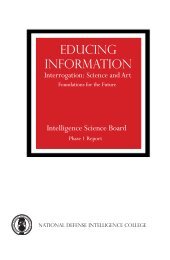COURTING A RELUCTANT ALLY - National Intelligence University
COURTING A RELUCTANT ALLY - National Intelligence University
COURTING A RELUCTANT ALLY - National Intelligence University
- No tags were found...
Create successful ePaper yourself
Turn your PDF publications into a flip-book with our unique Google optimized e-Paper software.
to little more than a nebulous statement on the part of the signatories to cooperatewith one another if war came. 308Despite this lack of cooperation on a strategic and operational level, both theU.S. and the UK still sought ways to increase exchanges between their intelligenceorganizations in the theater. Historically, exchanges in the Far Eastern theaterhad been relatively informal, primarily at the attaché-to-attaché level. 309 Thissituation began to change in October 1940, when, as previously discussed, anagreement was reached through the Joint Bailey Committee to exchange liaisonofficers between Great Britain’s China Fleet and the U.S. Asiatic Fleet. 310 Thiswas still a limited means of exchanging information, however, and officials inBritish intelligence felt more could be done to engage the U.S. in this theater.Plans were made to undertake initiatives that would increase cooperation in theFar East.The first move toward greater cooperation in the Orient came on the heels ofthe Sinkov Mission when, in March 1941, the British DNI, RADM Godfrey,authorized an exchange of SIGINT information between the British Far EastCombined Bureau (FECB) in Singapore and the U.S. cryptologists at StationCAST in the Philippines. By 14 March, the FECB had given the U.S. partial solutionsto a Japanese Army transport code and a cipher used by their Air Force. By23 March the FECB was given approval to accept two U.S. Army cryptologists asliaison officers. 311 Starting in May 1941, the U.S. Navy and the FECB worked outthe details of their exchange, which was significant. Lieutenant Jefferson Dennison,the officer-in-charge at Station CAST, traveled to Singapore in April or earlyMay to explore the possibility of greater cooperation. The Navy was still trying tobreak the main Japanese Fleet code, JN-25B, but was having only limited success.To foster good will and increase cooperation, the British provided all thework they had done on JN-25B and the addition of the code groups they hadrecovered was a significant help to the Americans, who likewise provided thework they had done on the code. 312Following Dennison’s visit, in May 1941, Commander Malcolm Burnett of theRoyal Navy arrived at Corregidor to work out the final details of a SIGINT-sharingarrangement between the FECB and Station CAST. While the British werefarther along in their code breaking efforts, they lacked reliable access to traffic308 Bath, 156-157.309 Dorwart, Conflict of Duty, 133-134; Bath, 135.310 Bath, 155-159.311 Smith, Ultra-Magic Deals, 78; Antony Best, Britain, Japan, and Pearl Harbor: Avoiding Warin East Asia, 1936-1941 (New York: Routledge, 1995), 146.312 Smith, Ultra-Magic Deals, 78; Erskine, 63-64.86
















